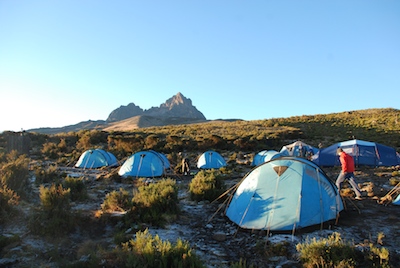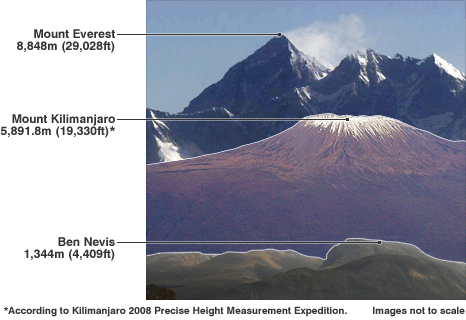There are a couple of things most travellers will already know about Mt Kilimanjaro: the fact that it is situated in the northern portion of Tanzania, within the Kilimanjaro National Park; the fact that it covers an area of 100 metres long and 65 metres wide; or the fact that it is Africa’s highest mountain. Most adventurers will also know that Mount Kilimanjaro is made up of three volcanic cones (Kibo, Mawenzi, and Shira) and is itself a dormant volcanic mountain. However, this certainly doesn’t mean you know ‘pretty much all there is to know’ about the spectacle that is Mount Kilimanjaro. So, for your reading pleasure, here are twenty facts about the majestic Mountain that you probably didn’t know.
1 Approximately 25,000 people attempt to summit Mt. Kilimanjaro annually. Approximately two-thirds are successful. Altitude-related problems is the most common reason climbers turn back.
2. Shamsa Mwangunga, National Resources and Tourism minister of Tanzania, announced in 2008 that 4.8 million indigenous trees will be planted around the base of the mountain, helping prevent soil erosion and protect water sources.
3. South African Bernard Goosen twice scaled Mt. Kilimanjaro in a wheelchair. His first summit, in 2003, took nine days; his second, four years later, took only six. Born with cerebral palsy, Goosen used a modified wheelchair, mostly without assistance, to climb the mountain.
4. The oldest person ever to summit Mt. Kilimanjaro was 87-year-old Frenchman Valtee Daniel.
5. Mount Kilimanjaro is the tallest mountain on the African continent and the highest free-standing mountain in the world.
6. The mountain’s snow caps are diminishing, having lost more than 80 percent of their mass since 1912. In fact, they may be completely ice free within the next 20 years, according to scientists.
7. The fasted verified ascent of Mt. Kilimanjaro occurred in 2001 when Italian Bruno Brunod summitted Uhuru Peak in 5 hours 38 minutes 40 seconds. The fastest roundtrip was accomplished in 2004, when local guide Simon Mtuy went up and down the mountain in 8:27.
8. Almost every kind of ecological system is found on the mountain: cultivated land, rain forest, heath, moorland, alpine desert and an arctic summit.
9. Nearly every climber who has summitted Uhuru Peak, the highest summit on Kibo’s crater rim, has recorded his or her thoughts about the accomplishment in a book stored in a wooden box at the top.
10. Kilimanjaro has three volcanic cones, Mawenzi, Shira and Kibo. Mawenzi and Shira are extinct but Kibo, the highest peak, is dormant and could erupt again. The most recent activity was about 200 years ago; the last major eruption was 360,000 years ago.
11. Douglas Adams, the late famous author of the legendary Hitchhiker’s Guide to the Galaxy series, took part in a Mt Kilimanjaro hike dressed in a rhinoceros suit for the British charity organisation, Save the Rhino International.
12. A porter from the very first successful summit lived to see the 100th celebration of the climb at an incredible 118 years of age!
13. Out of every 1,000 tons of water that trickles down the Mountain, approximately 400 of them come directly from ice caps.
14. Virtually every type of ecological system can be found on this mountain, including cultivated land, rain forest, heath, moorland, alpine desert, and an arctic summit.
15. Spanish mountain runner, Kilian Jornet, made the fastest ascent up the mountain in September 2010, at just 22 years of age. He reached the top of the Mountain in a startling 5 hours, 23 minutes and 50 seconds.
1 Approximately 25,000 people attempt to summit Mt. Kilimanjaro annually. Approximately two-thirds are successful. Altitude-related problems is the most common reason climbers turn back.
2. Shamsa Mwangunga, National Resources and Tourism minister of Tanzania, announced in 2008 that 4.8 million indigenous trees will be planted around the base of the mountain, helping prevent soil erosion and protect water sources.
3. South African Bernard Goosen twice scaled Mt. Kilimanjaro in a wheelchair. His first summit, in 2003, took nine days; his second, four years later, took only six. Born with cerebral palsy, Goosen used a modified wheelchair, mostly without assistance, to climb the mountain.
4. The oldest person ever to summit Mt. Kilimanjaro was 87-year-old Frenchman Valtee Daniel.
5. Mount Kilimanjaro is the tallest mountain on the African continent and the highest free-standing mountain in the world.
6. The mountain’s snow caps are diminishing, having lost more than 80 percent of their mass since 1912. In fact, they may be completely ice free within the next 20 years, according to scientists.
7. The fasted verified ascent of Mt. Kilimanjaro occurred in 2001 when Italian Bruno Brunod summitted Uhuru Peak in 5 hours 38 minutes 40 seconds. The fastest roundtrip was accomplished in 2004, when local guide Simon Mtuy went up and down the mountain in 8:27.
8. Almost every kind of ecological system is found on the mountain: cultivated land, rain forest, heath, moorland, alpine desert and an arctic summit.
9. Nearly every climber who has summitted Uhuru Peak, the highest summit on Kibo’s crater rim, has recorded his or her thoughts about the accomplishment in a book stored in a wooden box at the top.
10. Kilimanjaro has three volcanic cones, Mawenzi, Shira and Kibo. Mawenzi and Shira are extinct but Kibo, the highest peak, is dormant and could erupt again. The most recent activity was about 200 years ago; the last major eruption was 360,000 years ago.
11. Douglas Adams, the late famous author of the legendary Hitchhiker’s Guide to the Galaxy series, took part in a Mt Kilimanjaro hike dressed in a rhinoceros suit for the British charity organisation, Save the Rhino International.
12. A porter from the very first successful summit lived to see the 100th celebration of the climb at an incredible 118 years of age!
13. Out of every 1,000 tons of water that trickles down the Mountain, approximately 400 of them come directly from ice caps.
14. Virtually every type of ecological system can be found on this mountain, including cultivated land, rain forest, heath, moorland, alpine desert, and an arctic summit.
15. Spanish mountain runner, Kilian Jornet, made the fastest ascent up the mountain in September 2010, at just 22 years of age. He reached the top of the Mountain in a startling 5 hours, 23 minutes and 50 seconds.


















